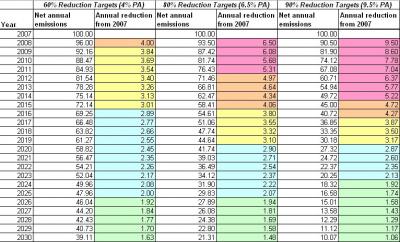I was in the middle of writing an article and, you know how things are, you get stuck on an idea and try a different way of looking at things. In this case I wanted to show how moving our electricity consumption to the night time could reduce the overall generating capacity needed, but I also needed to say this in the context of the startling, but real need to reduce Western greenhouse gas emissions by 90% (at least) by 2030.
I’ll say that again: If you live in the industrial West, you need to reduce your greenhouse gas emissions by at least 90% by 2030.
This isn’t some made up figure, it is backed by a very strong scientific analysis, not least the knowledge that what we do now will only truly show itself in 50 years time, and what we have done in the past is showing itself now. Immediate and dramatic reductions in greenhouse gases are the only option if that future emissions are to not overlay our past and current emissions, and also to ensure that the carbon sinks that are currently just about absorbing carbon are going to keep doing their job.
If you want a shockingly stark picture of this, go to David Wasdell’s analysis of our current situation. It does not make for pleasant reading. David Wasdell is not someone you want to get into a mental slanging match with; when he says, “Most of the systems known to affect Climate Change are now in net positive feedback”, then you need to listen.
Reducing our greenhouse gas emissions by 90% by 2030 sounds impossible. With the current cultural environment of excess and artificially generated need in place then you are probably right, but here’s a little thing that may just fix that: by making the kind of dramatic reduction that is needed, on a personal level you are, in effect, rejecting the culture that we have all unwittingly become part of. The systems that drive this culture will not be able to stand up to this type of rejection: they will either lie and cheat even more to gain your trust again, or they will collapse.
So, this 90% target is extremely desirable from both an environmental and a cultural standpoint, and this table shows how easy it really is:
(click for larger version)
The column on the left shows the year. The next columns are in pairs, and the pair we are interested in is the one on the far right, the 90% one. The others are there to show how countries outside of the industrial West can achieve equivalent targets.
As you move to the next year row you will see the net annual emissions going down from 100, until at the 2030 row, it is almost exactly at 10. To achieve this you have to reduce your emissions by 9.5% each year. In years 1 and 2 there are plenty of easy things you can do, but as you go on it seems to get more difficult as you run out of easy ideas. But that’s not a problem, because the actual reduction compared to year 1 reduces each year.
By 2010, you need a 7.78% annual reduction compared to 2007.
By 2020, you only need a 2.87% annual reduction.
By 2030, the last year, you only need a 1.06% annual reduction.
Although you are still reducing your annual emissions by 9.5% compared to the previous year, the actual reduction is a fraction of the first one because you have already reduced your emissions by a certain amount. Not only that, but you are now in the habit of reducing emissions, so setting annual targets will become second nature.
For the really keen (and this is even better for the planet) reduce your emissions by a huge amount early on, and it will be far easier in later years.
However you do it, and you must keep below the “net annual emissions” figure for that year, you will be making huge strides in saving your planet, your life support system, and your future.
Keith Farnish
www.theearthblog.org
www.amatterofscale.com

2 thoughts on “90% Emissions Reductions By 2030? Easy!”
Comments are closed.